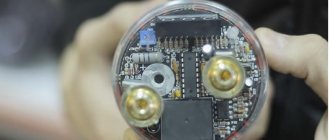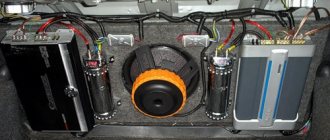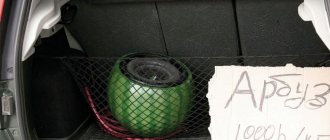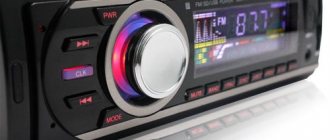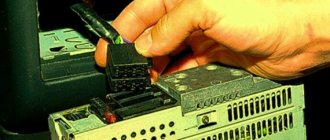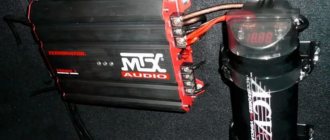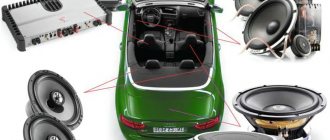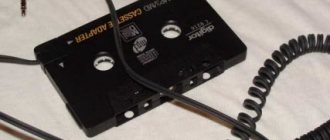Audio devices for high-quality sound reproduction consist of several components. This is a low-frequency amplifier and a certain number of speaker systems called satellites. The high-quality sound system is labeled 7.1. This means that it includes seven devices with full-range speakers and one low-frequency or bass system. This device reproduces a narrow band of audio frequencies. The lower threshold is 20-25 Hz, and the upper one usually does not exceed 150-180 Hz. Low frequency design comes in two types. This is a passive or active bass system.
The passive unit for reproducing bass frequencies consists only of a cabinet and a woofer. The resistance of the device matches the resistance of the voice coil. The passive unit can be connected in parallel with full-range speakers, and the total resistance is reduced. To avoid burning out the low-frequency amplifier, you need to calculate the resulting system resistance. The main component of an active sound system is a low-frequency amplifier with a correction filter at the input.
Connecting a subwoofer through speakers
Often the sound system does not have a low-frequency block, and there are not enough bass frequencies for high-quality music reproduction. Then the low-frequency device has to be connected independently. Typically, this problem has to be solved in a car because the standard package includes only front and rear speakers and you have to connect the sub through the speakers. Some models of car radios are equipped with a special connector for connecting a low-frequency device, but standard radios do not have such connectors. If you plan to install a passive speaker, then to obtain high-quality reproduction of low frequencies you need to install a separate amplifier. Many car owners, in order not to create unnecessary problems for themselves, connect the low-frequency unit through car speakers. To connect an active subwoofer through the speakers, you will have to lay an audio cable and power wires.
Several connection features
If you connect a passive speaker, then you need to do this through an amplifier. It already has special inputs and outputs designed for connecting a low-frequency device.
Its connection also occurs through the use of an speaker cable.
Connecting an active subwoofer to speakers
Note: to select a wire with a suitable cross-section for the subwoofer, you can use special tables.
Table for selecting wires for a subwoofer
The amplifier is connected directly to the radio using a cable with an RCA connector:
- If it is not possible to purchase an additional amplifier, then you can do without it. In this case, the device will be connected directly to the front speakers. But you need to understand that in this case the sound quality will be much lower. At the same time, when connecting an active device, you can do everything the same, but the speaker system will sound good;
RCA cable
- In order for sound to be filtered, a special filter can be installed at one specific connection point (see It’s not difficult to make a filter for a subwoofer yourself). Its location is usually indicated on the diagram.
Cable cross-section and proper selection
Note: It acts as an amplifier to some extent, but the bass performance is only slightly improved.
- Therefore, it is better to choose a connection through an amplifier, due to which the load on the speaker becomes less pronounced.
How to connect speakers to an active subwoofer
Subwoofer connection diagram
Before starting work, you should turn off the power to the car. To do this, you need to disconnect the negative terminal from the battery.
Only after this you can start working:
- First you need to decide where exactly the device will be located. After this, you will need to run a cable from the radio to it;
- The wires are laid under the interior trim. To facilitate work, there are special technical holes through which cables are routed.
Connecting an active subwoofer from the rear speakers
Note: it is advisable that the cable be run overhead, under the roof. Due to this, the load on the cable will be greatly reduced.
- The wire must be secured along its entire length. For this you can use special clamps. To prevent it from being visible in the future, the cable can be carefully disguised;
- In the place where the subwoofer will be installed, it is recommended to lay shock-absorbing material, which will protect the device from unnecessary vibrations;
- The amplifier should not be placed near the subwoofer as this may cause interference. It is desirable that it be located at some distance from it. In this case, both devices must be fixed with bolts;
- The cables must be inserted into the connectors provided for this purpose.
Connecting an active subwoofer through the rear speakers
In a car, the main sound comes through the front speaker systems. Rear speakers are additional, so a low-frequency device is often connected to them. Connecting a subwoofer through the rear speakers ensures normal reproduction of bass frequencies, without the need for an additional amplifier. Connecting a subwoofer from the rear speakers depends on the design of the device. There are two terminals on the rear panel of the passive low frequency system. This is the plus and minus of the woofer. These terminals are connected by speaker cable to the corresponding terminals of the rear speakers of the car. The low-frequency system is connected by a bridge to the plus and minus of different channels of the amplifier, as shown in the figure. The cross-section of the copper stranded wire should be as large as possible, as this reduces resistance and losses during signal transmission. The subwoofer is connected through the rear speakers using a cable from 2.5 to 4.0 mm2.
Which wire is better to connect the speakers?
For decades now there have been debates about the sound quality of speaker systems, and there have been debates about the wires that connect these speakers to the amplifier for just as long. What wire is better to connect the acoustics? Simple, electrical or acoustic wires made of “oxygen-free copper”? Let's talk a little about this.
As “Vicky” tells us – “ Oxygen-free copper
— electrolytic copper, free from copper oxides.” Purely technically, the production of such copper is not a simple process, but it is not particularly interesting to us now. Let's not go deeper into this aspect.
We are interested in the question - are there any advantages to audio wires made of “oxygen-free copper” over ordinary copper, stranded wires that are used when installing electrical wiring in the house? So we'll figure it out.
Samples of the wires in question
The first sample is an acoustic cable
The wire tested was an OEHLBACH 2*2.50 mm acoustic cable. It is usually sold in coils wound around a frame. Below are brief characteristics of the manufacturer.
- High quality stereo speaker cable. This speaker cable is for use with amplifiers rated at approximately 150 watts per channel.
- The outer sheath of this Oehlbach cable is made of several types of durable and flexible plastic.
- The inner conductor is made of several individual wires wound together to form a bundle, so this cable is highly flexible and easy to install.
- Oxygen-free copper (OFC) was used as the internal conductor material, ensuring high reliability of data transmission.
The line in the description sounds strange: “High-quality stereo speaker cable.” It looks like this cable is stereo! No, apparently it was a typo. And why did the manufacturer decide that this particular cable (2.5 mm) can be used for acoustics of approximately 150 watts. Will this wire not withstand a two hundred watt amplifier?
There is no arguing that he is very flexible. Indeed, the thickness of the cable's wire tells us that it will be quite rigid. But no! Unexpectedly, the cable is very elastic, as stated, due to the production technology. This is probably the best way to connect your speakers.
The latter is a statement that the copper used is oxygen-free. This is the topic of conversation. Further.
Second sample - electrical cable
The second wire being tested is the most ordinary, electrical one, for electrical wiring. We took PVS 2x2.5. In stores you can see bays of 50, 100 meters, but you can also find bays of 200 meters. Brief description of application and characteristics.
Explanation of the marking of the PVS 2x2.5 wire
- P – wire;
- B – insulation and sheath made of PVC plastic;
- C – connecting;
- 2 – Number of conductors
- 2,5 – Nominal conductor cross-section (mm 2 )
Description of the use of PVA wire 2x2.5
- For connecting electrical appliances and power tools for home care and repair, washing machines, refrigerators, small-scale mechanization equipment for gardening and other similar machines and devices, and for the manufacture of extension cords for voltages up to 380 V with a nominal frequency of 50 Hz;
By comparing wires of the same size (section diameter), as well as taking into account the length of the wire, you can get some differences in the quality of insulation, often in the thickness of the conductor section. Yes, not all manufacturers adhere to certain standards and requirements. And on the shelves you can see a wire with a declared cross-section of 2 * 2.5 mm 2, but in fact it turns out that it is 2 * 2.0 mm 2. You should be more careful when choosing a wire.
From this wire we often make various kinds of extension cords for our household needs. They will certainly be able to withstand a washing machine, a refrigerator and an iron, even turned on at the same time. It rarely occurred to anyone to specifically connect acoustics with just such a wire. Although for many, the speakers are connected with an electric wire.
Comparison of acoustic wire and electric
Appearance and rigidity
And so, let's continue studying and comparing. Let's strip the insulation and look at the copper conductors themselves.
This wire is acoustic, the manufacturer's name is OEHLBACH
The other wire is electrical, the manufacturer can be any, but its appearance will be the same.
Purely visually, they are immediately different. The first sample was very soft to the touch and bending, which caused me some caution and suspicion - “will it really be able to withstand the loads declared by the manufacturer?” Hope so. The second wire is three times stiffer in bending.
What causes this? Looking at the wires, you can immediately notice that each wire of the second wire (electric) is much thicker than that of the audio wire (acoustic). This is the reason for such a “softness” to the touch.
How to connect a subwoofer to speakers in a car
In order to improve the quality of low frequency reproduction, it is recommended to connect the subwoofer to the speakers in the car through a passive crossover filter. You can use an industrial product or assemble the filter yourself. For a cutoff frequency of 150 Hz with a speaker resistance of 4 Ohms, the following ratings of radio components will be required:
- Capacitor capacity – 180 mF
- Coil inductance – 6 mH
For the filter to work correctly, you need to use special capacitors for speaker systems such as K73-17 or K78-34. To wind the inductance, copper wire with a diameter of 1.0 mm and a length of 84 meters is used. The mandrel can be any, made of wood or plastic. Connecting the subwoofer through the rear speakers will allow you to almost completely get rid of unnecessary frequencies in the audio range. If the speaker has a different impedance and a different cutoff frequency is needed, the easiest way is to use an online calculator to calculate filters. When connecting an active subwoofer through speakers, use the high level inputs.
Some low frequency systems do not have high level inputs. Then to connect the device you need to use an adapter for the subwoofer through the speakers. In its simplest form, the device is a resistive voltage divider-signal adder. The wires without connectors are connected to the rear speakers, the black wire should be connected to the vehicle ground, and the wires with connectors are connected to the low-level inputs of the low-frequency acoustics. The lines going to the rear speakers and ground can be increased in any convenient way.
Nowadays, no sound system of any quality can do without a good subwoofer. This device allows you to achieve the highest quality reproduction of sound files, as it significantly expands the range of sound waves emitted by the system. While conventional speakers are used to reproduce the basic range of human audibility, a low-frequency subwoofer specializes in sounds that are at the lower limit of audibility - 20-80 Hz.
It is very simple to understand whether the selected sound system has a subwoofer - its presence is indicated by a separate number in the speaker system index. So, the numbers in the name of the system type mean:
- 2.1 – that it contains two front speakers and a subwoofer.
- 3.1 – front, center and low-frequency speakers.
- 5.1 – front, rear, center speakers and subwoofer.
- 7.1 – front, side, rear, center speakers and low-frequency converter.
Why is there only one subwoofer in the system? The fact is that it is difficult for a person to understand where the low-frequency sound is coming from. Therefore, unlike conventional speakers, there is no need to increase the number of low-frequency emitters and position them in different places in the room - just place the subwoofer somewhere under the table, and the bass will be felt approximately the same anywhere in the room.
For the system to function as it should, all its elements must be properly connected to each other, and then connect the entire system to a sound source - a computer, TV or home theater. Depending on the type of system and the design features of individual devices, the complexity of this procedure may vary, but even the most difficult option can be quickly figured out by carefully studying the user manual and the nuances of installing acoustics. So, how do you connect speakers to a subwoofer?
How to connect a 2-channel amplifier
In the last article, I told you about how to connect a 4-channel amplifier, if you don’t know, check it out.
In this article I want to tell you everything about connecting a 2-channel amplifier using the DLS CA-22 as an example.
So, in this article we will look at:
1) What is a 2-channel amplifier, what is it used for.
3) Application options.
4) Connection diagrams.
Well, let's all go in order
